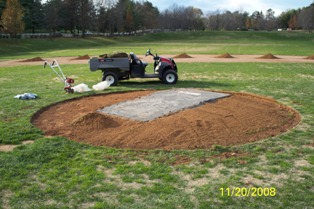For years vacationers have flocked to the Myrtle Beach area for family fun on the beach and on the golf course. Now, the Grand Strand has found a new market to attract visitors: sports tourism. While the Myrtle Beach area has seen the golf market level off, the sports tourism market has grown and city managers and business developers up and down the coast have taken notice. A marked expansion of athletic complexes along the 60+ miles of the Grand Strand has taken place over the past several years.
Among baseball enthusiasts it is no secret that Myrtle Beach is home to The Ripken Experience, a top-notch baseball facility with numerous synthetic fields. For years The Ripken Experience has attracted a large number of tourists in the travel baseball market and the facility continues to expand and improve. Another large scale investment has been undertaken by the city of Myrtle Beach. In recent years the city has added an impressive array of both natural and synthetic fields, highlighted by the outstanding baseball and multi-use facility at the Market Common, a high-end shopping and dining venue development. But perhaps the most aggressive expansion into the sports tourism market has come from the city of North Myrtle Beach.
In April 2014, the city of North Myrtle Beach will open a new 162-acre sports field park to attract an even larger segment of the sports tourism market. The North Myrtle Beach Park and Sports Complex will include eight regulation size soccer fields that have been constructed for multiple field configurations. Four softball fields and two baseball fields are included in the site which is all planted in Tifway 419 bermudagrass. The softball fields have 225-foot outfields while the baseball fields stretch to 330 feet at the lines and 380 feet in center field. With the use of adjustable fencing the softball and baseball fields can accommodate almost any event played on a diamond.
While the new park will highlight sporting events, the attraction won’t stop there. Twenty acres of lakes are included and will have water activities. Other amenities including playgrounds, an amphitheater, two dog parks, walking trails, and a well-manicured open field area for festivals have also been included. “We tried to create a sports complex within a park setting,” said Jim Grainger, Public Grounds Superintendent for the city of North Myrtle Beach. But the park goes further than that. An effort to protect the local eco-system was integral to the construction process. Besides saving important local trees and plants for native habitat the park grounds are self-supporting from an irrigation standpoint. The ability to recapture the water that will be used reinforces the parks concept that sports tourism and turfgrass management can be an environmental partner.
The biggest winner in the construction of the new park will be the local economy. John Bullard, Director of Parks and Recreation for North Myrtle Beach, envisions a bright future for the park. “The park could have a $15-$18 million dollar economic impact for our area,” he said. This could be, pardon the pun, a home run for the Grand Strand. The city of North Myrtle Beach began planning for the park several years ago and created general obligation bonds in the amount of $15 million to establish the creation of the park. It’s easy to see how quickly this investment could pay off.
Matt Gibbons, Superintendent of Sports Tourism, has been marketing the new park and says the response has been tremendous. “We knew we had to do more than 40 events in the new park annually. We thought we would do 60, but we are already at 70 events for the first year and we don’t open till April!”
It’s obvious that North Myrtle Beach will see the new park fill a need in the marketplace. Matt continued, “The park will have its grand opening by hosting the World Cup of Quidditch.” Quidditch, a game made popular by Harry Potter films, has evolved into a huge sport, especially at the university club sport level. Matt shared that more than 80 teams and potentially thousands of spectators are expected at the grand opening World Cup event, only adding to the multi-use agenda of the park.
All this investment up and down the coast serves to increase the sports tourism market that continues to grow. So what’s next for the Grand Strand? Has the area filled the void or even saturated it? Not yet according to Steven Rabon of S and R Turf and Irrigation, the contractor who built the sports fields at the new park. “We built 17 new fields around the Grand Strand in 2013 and are scheduled to build seven more nearby in North Carolina in 2014,” Steven said. Perhaps the Myrtle Beach area will have to change its marketing strategy from the golf capital of America to the “Sports Tourism Capital of America.” Only time will tell.
Ashley Wilkinson is a professor of golf and sports turf management at Horry-Georgetown Technical College in Myrtle Beach, SC.


